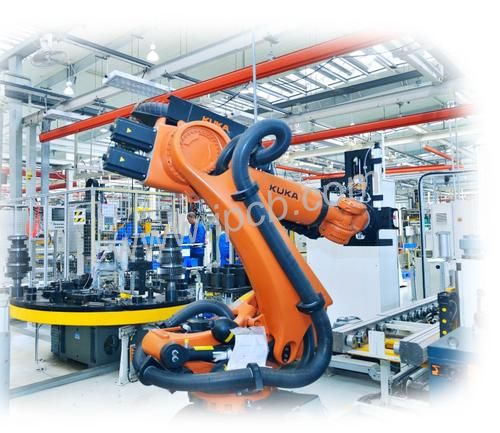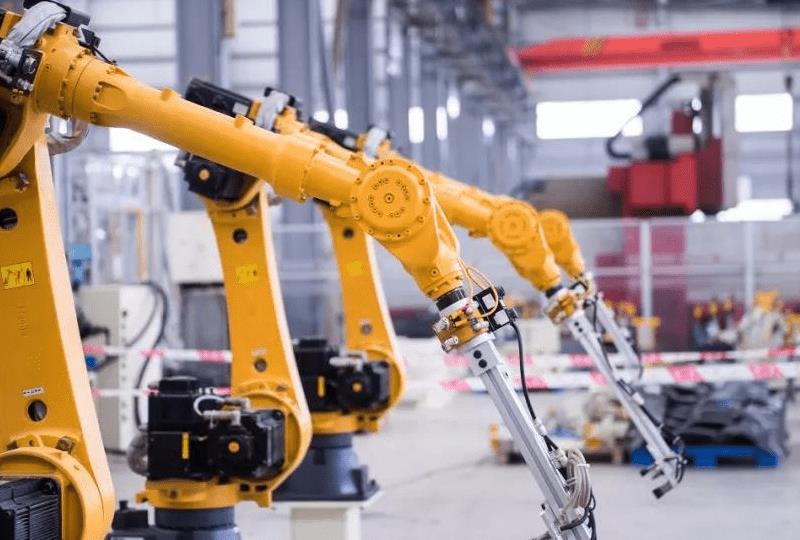The widespread application of industrial robots contributes to the emergence of new industrial demands.
From the distribution of application fields of industrial robots, automotive and motor manufacturing are currently the two main application fields, accounting for about 30% of the market respectively. The main usage scenarios are handling, welding, and loading and unloading., In addition to the increased automation requirements due to the shortage effect, industrial robots expand their functions by incorporating artificial intelligence and sensor technology, bringing new capabilities that are different from previous operating rules.

Industrial robot
At present, intelligent robots with cognitive learning ability and autonomous adjustment ability can design special functions according to industry needs to adjust complex work scenarios, extending their application reach to more emerging industries.
In the era of mass production mode, in order to maximize production efficiency and save labor costs, such as loading highly repetitive or difficult and dangerous work on the machine, it is generally operated by industrial robots and mainly used for bulk loading. Under the conditions of repeated use or heavy workpiece weight, this is currently a common application of loading robots.
However, due to the fact that most of these robots perform repetitive tasks and have a simple task set, their relative motion paths and actions must be designed in a fixed pattern. Therefore, the work often requires additional manual labor to wait for incoming commands to be processed again for the materials on the clip. This is currently a lack of flexibility in the application of top-down materials, and improvements are expected.
In short, automated loading and unloading can only solve half of the problem. Compared to humans, robots find it difficult to randomly extract parts from containers and accurately insert them into the machine. Defect improvement application and market random development robot Random Bin Picking technology, combined with AI and 3D vision, can recognize information such as the position, posture, and placement order of objects. Through AI adaptive cutting paths and taking actions, because workpieces are not available and can be arranged in advance, it effectively improves the production efficiency of many factories.
In the metal processing industry, it is not as popular as welding robots. The grinding and polishing process still heavily relies on manual labor. Due to the complex shapes of holes and multiple curved surfaces in water metal products, it is difficult to introduce automation. However, in the hardware industry, the shortage of polishing technology in China is becoming increasingly severe, which has led to an increased demand for polishing robots in the market. In 3D vision and practical integration systems, for robots that require complex polishing paths, the difficulty of path generation can be reduced to achieve stable processing.
It is worth noting that in addition to industries such as automobiles, electronic motors, and mechanical metal processing as the main application areas, Huang Zhong, an analyst at the International Institute of Obstetrics and Gynecology, observed that light industry robots, including textiles and shoes, are also constantly developing and gradually moving towards automation and intelligence in food processing. For example, in the footwear industry, there are also complex processing paths in gluing and polishing, and 3D vision is now being used to guide improvements, or manufacturers are developing robotic arms to help clothing manufacturers improve the sampling process.

Industrial machinery
The development of industrial robot technology has gone through three stages
Stage of emergence and initial development: 1958-1970. The first patent in the field of industrial robots was applied for by George Devol in 1958, titled Programmable Operating Devices. Joseph Engelberg was very interested in this patent and, together with DeVor, co manufactured the world's first industrial robot in 1959, called Robot. Its meaning is "a human hand holding a robotic arm, doing the tasks that should be completed, and the robot repeating the work according to the program taught to them in advance." It is mainly used in industrial production fields such as casting, forging, stamping, welding, etc., and is specifically called an industrial robot.
The stage of rapid technological progress and commercial scale application: 1970-1984. The technology during this period has made great progress compared to before, and industrial robots have begun to have offline program design with certain perception functions and self adjustment abilities, which can change their work content according to the condition of the work object. With the rapid progress and development of technology, industrial robots during this period also highlighted the characteristics of rapid commercial application. The "four major families" of industrial robots - KUKA, ABB, Yaskawa, and FANUC - began global patent layout in 1974, 1976, 1978, and 1979, respectively.
Intelligent robot stage: 1985 to present. Intelligent robots are equipped with multiple sensors, which can fuse the information obtained from the sensors and effectively adjust the changing environment. Therefore, they have strong self adjustment ability, learning ability, and autonomous function. After 2000, countries such as the United States and Japan began research on smart military robots. In 2002, the first "Boston Dynamics Big Dog" smart military robot patent was jointly applied for by a Boston company and a Japanese company. In 2004, a smart military robot patent was applied for with the support of the DARPA/SPAWAR program of the US government.
The development process of industrial robots in China has different characteristics from foreign countries, starting relatively late and can be roughly divided into four stages.
Theoretical research stage: 1970s to early 1980s. Due to the constraints of national economic conditions and other factors at that time, China mainly engaged in research on the basic theory of industrial robots, and made certain progress in robot manufacturing, robotics, and other fields, laying the foundation for subsequent research on industrial robots.
Prototype development stage: mid to late 1980s. With the widespread application and popularization of industrial robots in developed countries, China's research on industrial robots has received government attention and support. The country has organized research on industries with demand for industrial robots, invested a large amount of funds in the research of industrial robots, and entered the stage of prototype development.
Demonstration application stage: 1990s. During this stage, China has developed 7 industrial robot series products, including planar joint type unified robots, Cartesian coordinate robots, arc welding robots, spot welding robots, and 102 special robots, and implemented more than 100 robot application projects. In order to promote the industrialization of domestic robots, 9 robot industrialization bases and 7 scientific research bases were established in the late 1990s.
Initial industrialization stage: Since the 21st century. The Outline of the National Medium - and Long Term Science and Technology Development Plan (2006-2020) highlights the main line of enhancing independent innovation capabilities, focuses on creating a policy environment conducive to independent innovation, accelerates the promotion of enterprises as the main body of innovation, vigorously advocates enterprises as the main body, and closely integrates industry, academia, and research. A large number of domestic enterprises have independently developed or cooperated with research institutes to join the ranks of industrial robot research and production, and China's industrial robots have entered the initial industrialization stage.
After the four stages of development mentioned above, China's industrial robots have gained a certain degree of popularity. Data shows that by 2016, the number of industrial robots in China had reached 300000 units. However, compared with advanced manufacturing countries, there is still a significant gap in the usage density of industrial robots in China, and there is still huge room for growth in the number of industrial robots.